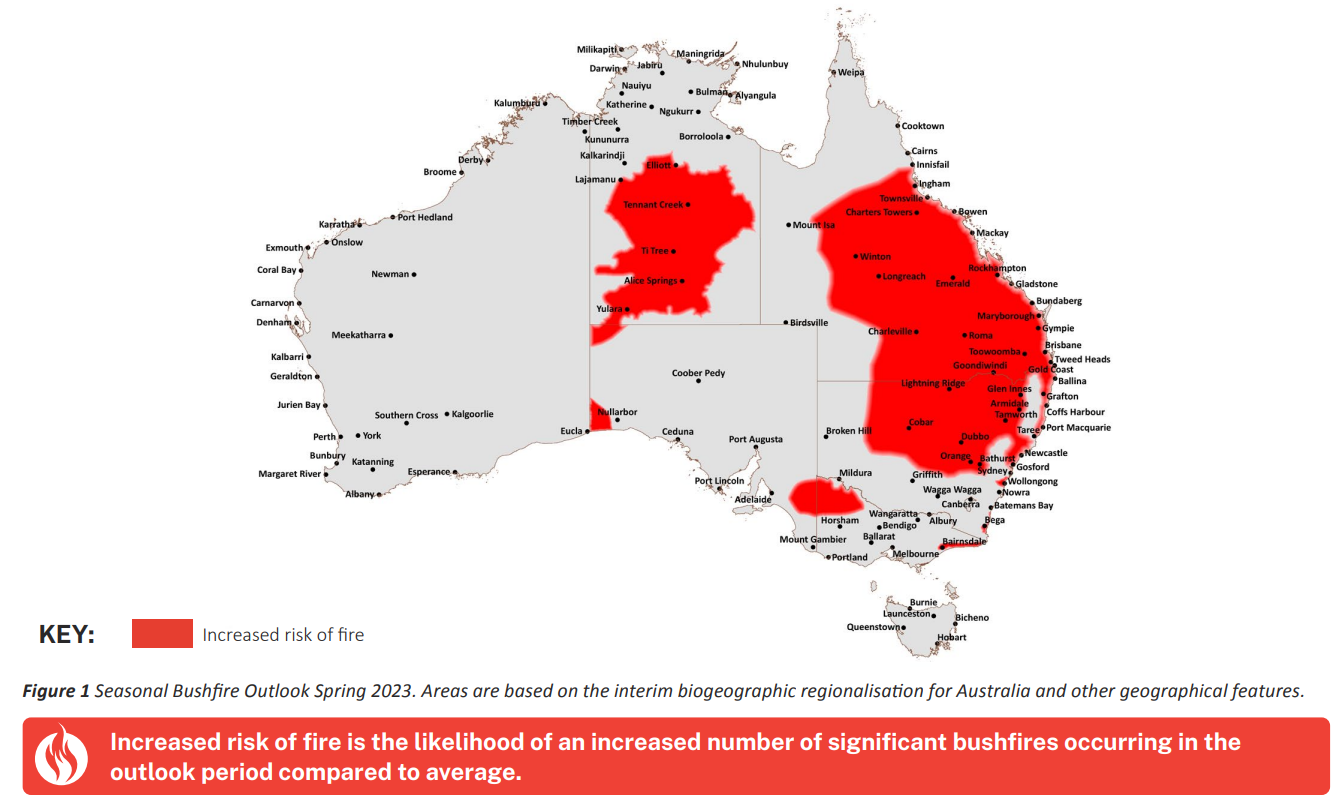National bushfire preparedness is well underway ahead of the high-risk weather season, with the Albanese Government coordinating efforts across the country to ensure communities are as ready as possible.
The
Seasonal Bushfire Outlook for Spring 2023, released today by
AFAC (the National Council for Fire and Emergency Services), predicts increased risk of fires across parts of New South Wales, Queensland, South Australia, Victoria and the Northern Territory in coming months.

Source: AFAC Seasonal Outlook: Spring 2023
Minister for Emergency Management, Murray Watt said unfortunately the forecast showed some areas which had experienced floods recently were also among those facing the highest risk of fire during spring.
“After a few seasons of intense rainfall and floods, we know that there will be a lot of stress for communities,” Minister Watt said.
“Many regions have seen lots of vegetation growth because of La Niña rainfall, which is contributing to increased risk.
“However the Seasonal Outlook predicts more fast-moving grass and scrub fires, rather than the longer forest fires experienced in 2019-20.
“As Australia heads into its first significant fire season since Black Summer it is crucial all three levels of government, along with emergency responders are ready.
“The Albanese Government, through the National Emergency Management Agency (NEMA) has been working closely with state and territory services to plan for the coming fire season, assessing capability and working to streamline response efforts.
“We stand ready to help whenever and wherever needed, and have commenced a number of preparedness activities to make sure we are ready for the season, based on recommendations from the Royal Commission into National Natural Disaster Arrangements.
“These include an additional National Large Air Tanker on hand to respond quickly, and a new fire danger rating system to be able to more simply explain to people what the fire risk is.
“We have also begun building a national stockpile of items that are needed in disasters, like emergency accommodation, backup generators, food and water, as we continue to do what we can to be as ready as possible.
“While governments and authorities are doing our bit to be better prepared, now is also the time for local communities to start preparing for the risk of potential fires and heatwaves, and I’d encourage Australians to make or update their fire action plans if they haven’t already.”
In the past 12 months, the Albanese Government has introduced significant improvements to the way Australia prepares for the higher risk weather season.
This includes:
- Co-investing $94 million this year in bushfire mitigation and preparedness with State and Territory governments through the Albanese Government’s flagship Disaster Ready Fund.
- Supporting the leasing and positioning of a national fleet of highly specialised firefighting aircraft for use by state and territory governments through the National Aerial Firefighting Centre (NAFC), and the lease of another National Large Air Tanker.
- The Federal Government’s new National Situation Room (NSR) and the National Joint Common Operating Picture, which enables collaboration amongst federal, state and territory government agencies and non-government organisations during a crisis including obtaining satellite imagery from partner agencies as well as predictive analysis to anticipate likely challenges and associated impacts on communities.
- Unifying the two arms of federal emergency management to create the National Emergency Management Agency (NEMA), to be more efficient in disaster management.
- Through NEMA, coordinating partnerships with state and territory emergency services organisations, industry, the not-for-profit sector and other representative groups, which will enable a higher level of readiness for the upcoming season.
- A new, simplified Australian Fire Danger Rating System so that no matter where someone is, they understand the fire risk and what action they need to take.
- Building a National Emergency Management Stockpile, which includes key resources such as emergency shelter, water and electricity, to enable states and territories to quickly access these resources in times of need.
- Investing in Disaster Relief Australia to provide recovery and clean up support after disasters. DRA’s veteran-led operating model provides a trained, on the ground force during recovery and relief efforts.








